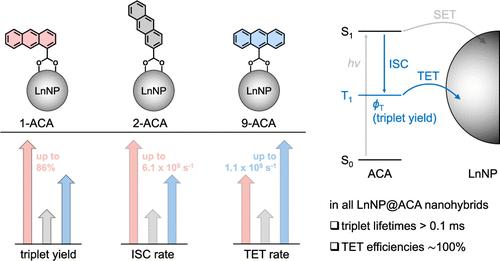分子取向控制有机分子与镧系掺杂纳米粒子耦合的三重态激子动力学
IF 15.6
1区 化学
Q1 CHEMISTRY, MULTIDISCIPLINARY
引用次数: 0
摘要
有机-无机混合材料结合了有机半导体(OSCs)和无机纳米颗粒的独特性能,在光电应用中显示出巨大的前景。了解这些纳米杂化体的结构-功能关系对于理解控制其激发态动力学的机制至关重要,特别是控制三重态激子的机制,这是其性能的关键。虽然之前的研究主要集中在界面上的三重态能量传递(TET),但我们研究了与各种镧系掺杂纳米粒子(LnNPs)耦合的OSCs中的全三重态激子动力学,重点研究了分子取向的影响。我们研究了三种蒽羧酸(ACA)异构体,它们在蒽核心上羧酸基团(1-,2-和9-位置)的位置不同。这些异构体在不配位时都表现出相似的三重态动力学和低三重态产率(~ 10%),但在LnNP表面上采用不同的结合几何形状,使它们成为研究配位几何形状如何影响三重态激子动力学的理想选择。利用时间分辨光谱学,我们观察到在与LnNPs配位后,ACA异构体之间的三重态生成速率、产率、寿命和TET速率发生了显著变化。三联体的产生率和产量始终在1-ACA中最高(高达86%),在2-ACA中最低。9-ACA的TET速率最快(可达1.1 × 108 s-1), 2-ACA的TET速率最慢。值得注意的是,在没有TET的情况下,所有LnNP@ACA纳米杂化体的三重态激子寿命都超过0.1 ms。这些结果定量地描述了位置异构如何控制LnNP@OSC纳米杂化体中的三重态激子动力学,并强调了分子取向在介导界面光物理中的关键作用。本文章由计算机程序翻译,如有差异,请以英文原文为准。

Molecular Orientation Controls Triplet Exciton Dynamics in Organic Molecules Coupled to Lanthanide-Doped Nanoparticles
Hybrid organic–inorganic materials, which combine the unique properties of organic semiconductors (OSCs) and inorganic nanoparticles, show great promise for optoelectronic applications. Understanding structure–function relationships in these nanohybrids is crucial for understanding the mechanisms governing their excited state dynamics, particularly those controlling triplet excitons, which are key to their performance. While previous studies focused primarily on triplet energy transfer (TET) across the interface, we study the full triplet exciton dynamics in OSCs coupled with various lanthanide-doped nanoparticles (LnNPs), with an emphasis on the impact of molecular orientation. We examine three anthracene carboxylic acid (ACA) isomers, differing in the position of the carboxylic acid group (1-, 2-, and 9-position) on the anthracene core. These isomers all exhibit similar triplet dynamics and low triplet yields (∼10%) when uncoordinated, but adopt distinct binding geometries on the LnNP surface, making them ideal for studying how coordination geometry influences triplet exciton dynamics. Using time-resolved optical spectroscopy, we observe significant variations in triplet generation rates, yields, lifetimes, and TET rates between the ACA isomers upon coordination onto the LnNPs. Triplet generation rates and yields are consistently highest in 1-ACA (up to 86%) and lowest in 2-ACA. TET rates are fastest for 9-ACA (up to 1.1 × 108 s–1) and slowest for 2-ACA. Notably, in the absence of TET, triplet exciton lifetimes exceed 0.1 ms for all LnNP@ACA nanohybrids. These results quantitatively describe how positional isomerism governs the triplet exciton dynamics in LnNP@OSC nanohybrids and highlight the pivotal role of molecular orientation in mediating interfacial photophysics.
求助全文
通过发布文献求助,成功后即可免费获取论文全文。
去求助
来源期刊
CiteScore
24.40
自引率
6.00%
发文量
2398
审稿时长
1.6 months
期刊介绍:
The flagship journal of the American Chemical Society, known as the Journal of the American Chemical Society (JACS), has been a prestigious publication since its establishment in 1879. It holds a preeminent position in the field of chemistry and related interdisciplinary sciences. JACS is committed to disseminating cutting-edge research papers, covering a wide range of topics, and encompasses approximately 19,000 pages of Articles, Communications, and Perspectives annually. With a weekly publication frequency, JACS plays a vital role in advancing the field of chemistry by providing essential research.

 求助内容:
求助内容: 应助结果提醒方式:
应助结果提醒方式:


